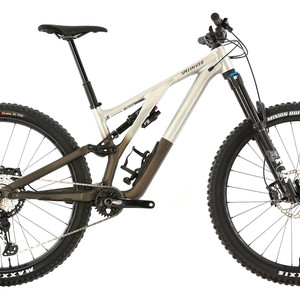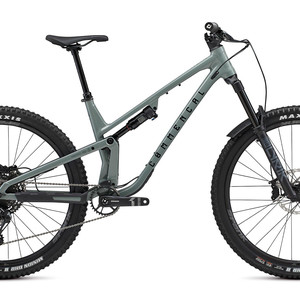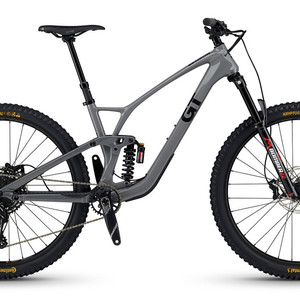2015 Cannondale Jekyll 27.5 4 Bike
(discontinued)
| Where To Buy | |||
|---|---|---|---|
Free shipping on orders over $50 (continental U.S. only).
International shipping available. Some exclusions apply. |
|||
Free shipping on orders over $50 (continental U.S. only).
International shipping available. Some exclusions apply. |
|||
Free standard shipping on orders of $50 or more (U.S. only).
International shipping available. Free on orders of $150 or more. Some exclusions apply. |
|||
1 member reviews
The Decision
I picked up my 2015 Jekyll 4 in June of 2014. This had been my first new bike in quite sometime and my quest for my new ride had a few requirements. 1. It had to have 27.5" wheels. 2. It had to have enough travel to be ridden aggressively on the ledgy technical trails around Las Vegas and Southern Utah. 3. I had to be able to pedal it, FAST.
The toughest part of my search was deciding upon how much travel my new sled should have. My previous bike had been a 26" 140mm travel bike with 130mm travel fork. And it weighed around the 30 lb mark. This seemed to do the trick for me so I started looking into bikes in this range. I considered a Trek Remedy, and a Cannodale Trigger, but then I demo'd a Jekyll. I was thinking that a 160mm travel bike was outside the realm of what I needed, and would punish me too much on the climbs. But during my 3 day demo period I rode 3 of my favorite Southern Utah Cross Country trails, Church Rocks, Paradice Canyon, and the Sidewinder/Barrel Roll trail network. Here is a snapshot of my results from strava;
I was a little shocked to see that a bike that was heavier and had more travel than my previous bike was faster in almost every situation, and I wasn't even used to the bike yet.
After my demo I decided on a Jekyll 4. The Jekyll 4 is the low end model in Jekyll family and retails for $3200. I am not an entry level bike kind of guy, but I felt that this model provided the best bang for the buck in a price that I could afford. The Frame is aluminum, which I like, and it came with the fabulous Pike RC. In addition the drivetrain and brakes were Shimano SLX, which I knew I could work with.
The Build
Upon purchasing this bike I had no intent on leaving the bike in its stock form. I was going to keep the parts of the bike that I liked, and use things that I liked for the rest. One place that I feel Cannondale missed the mark on this bike was not including a dropper post on this bike. This worked in my favor due to the fact that I really like Gravity Dropper posts, due to their durability. So I simply ordered a shim to adjust the size of my existing post to work on my new Jekyll. The next area that I addressed was the drivetrain. I am a big fan of 1X drivetrains so I set this up as a 1X10. I used a 32T raceface NW chainring with an OneUp Components 42 tooth cog. For shifting I used a Sram X-7 rear shifther and an X-9 type 2 rear derailleur. I also replaced the deore cranks that came on the bike with my Race Face cranks from my old bike for a little more durability.
At this point I had a 100% functional bike that shifted the way I wanted and had the braking and suspension performance that I needed. The other changes that I made could have waited but definitely improved the performance of the bike. First I replaced the stock WTB rims laced to Formula Hubs with a set of Atomlab Suprelite wheels. These sub 1800gram wheels made the bike track even better than it did, and dropped some weight off. But perhaps the biggest advantage was the high engagement rear hub and the advantage that gave me on technical climbs. Here is a link to my review of the wheels http://www.vitalmtb.com/product/guide/Wheelsets,44/Atomlab/Superlite-SL-650b,13387 My final change to the stock set up was the cockpit. For me the stock 50mm stem was a bit short, and the 750mm bars were a bit narrow. I again went to Atomlab for this. The 70mm Atomlab SL stem and 800mm DHR bars have a 35mm clamp which again added to the stiffness and precision of the bike as well as adding a bit of sexiness.
The overall build ended up being a 31.5lb enduro bike with a 1X drivetrain that rips up and levels everything in its path.
Fit, Feel, and Set up
The secret to the all-around performance of the Jekyll lies in two areas. The first is the Fox Dyad rear shock. This technology is nothing new so I’m not going to go into discourse about how it works, but I will simply say it works very well. By simply flipping a thumb shifter type lever you transform the bike from a 160mm bike with DH soft suspension to a 95mm travel XC bike. This technology does require a bit of extra set, because you have to set two pressures. The process is simple. One thing that I will point out is that the suggested settings are on the stiff side. With my riding gear on I weigh 180lbs. The recommended settings are 340lbs in the positive chamber and 300lbs in the negative. With these pressures the long travel setting is stiff and the short travel is downright harsh. I have found that reducing the pressures one and a half setting is just about right. I am running 310 and 275 respectively.
The Rock Shox Pike RC solo air is simple to set up. I set it up with right about 30% sag to match the rear. For me this is about 35lbs which is significantly off of what Rock Shox recommends.
The other brilliant part of this bike is its geometry. It seems like the heart of all enduro bikes now days centers around the top tube length. My size large has an effective top tube of 24.4 inches. This puts it right where it should be for this type of a bike. I like to stretch out a bit so I increased the stem length by 20mm. The head tube angle is a somewhat steep 67 degrees. Many other companies are going as slack as 64 degrees on their enduro bikes. For a bike that is intended to an all-around monster the 67 degree head angle allows this bike to pedal up steep terrain without the front end excessively wondering. To improve this even further, when you put the bike into the short travel mode the head angle steepens an additional half a degree.
Climbing
As pointed out above the bike will climb like a XC monster in the short travel mode, well as fast as a 31lb CC monster can climb. In the elevate mode there is little to no pedal bob and it seems as it every bit of your input is rewarded. The one gripe is that on exceptionally rough climbs you may want to climb either standing or in the long travel mode increased traction.
The dialed geometry allows you to maneuver steep switchbacks with ease. It took me a while to adjust to the “new school” low bottom bracket height to avoid hitting obstacles with my pedals while climbing, but with the high engagement rear hub of my new wheels I soon found myself ratcheting up these technical climbs with ease.
The Rock Shox Pike RC lacks a low speed compression adjustment but I have found that the stock setting is supportive enough for aggressive seated climbing. If you are doing extended climbing there is an easily accessible compression damping adjuster on the top of the right fork leg. This has 13 clicks and will take you from full open to a near lock out. I ride with it in full open most of the time unless I am on the road.
Descending
I guess WOW is the right word. For me descending is an aggressive pedaling experience where simply riding down the hill perched atop a marshmallow is not good enough. I need to be able pedal and have that pedaling rewarded with an increase in downward momentum. The Jekyll does just that. This bike is not a playful park bike that pops off of every lip and hit. Instead it is a planted peed sled that encourages you to beat your PR every time down the hill.
This bike loves to be cornered aggressively! Go in hard, brake late, get off the brakes and let it rocket out. I have never been real comfortable railing berms but my Jekyll keeps asking me to hit them harder and higher. Steep chutes are no problem either. Just point and shoot and the long front center will guide you through without a scratch.
Perhaps the area of riding that this bike has improved my riding the most is in the area of drops. Not the “let’s go hucking” kind of drops but the kind where you fly off a 3-4 footer, land on a foot and half wide trail and then make 90 degree left turn. On other bike I would land with a bounce and feel out of control going in to corner. My Jekyll has increased my confidence in these situations because of the way it immediately plants you and allows you to set up for the next obstacle.
Overall Impressions
When you view the changes that have been going into the building of trails in today MTN biking world, the needs of our bikes have changed. We are basically demanding mini-downhill bikes that can be pedaled quickly and efficiently up any and all hills. With these criteria in mind the Jekyll will exceed your expectations. It truly is a bike that can do it all. It is not perfect. The weight is a bit high, and the “middle ground” between the two suspension settings can leave something to be desired, but I haven’t found a bike that can do what this bike does as well.
Specifications
| Where To Buy | |||
|---|---|---|---|
Free shipping on orders over $50 (continental U.S. only).
International shipping available. Some exclusions apply. |
|||
Free shipping on orders over $50 (continental U.S. only).
International shipping available. Some exclusions apply. |
|||
Free standard shipping on orders of $50 or more (U.S. only).
International shipping available. Free on orders of $150 or more. Some exclusions apply. |
|||






















0 comments
Post a reply to: Great Enduro Starter Platform